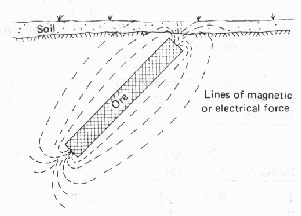Mining in Manitoba
Geophysical Methods
 |
|
In nature, the induced polarization (I.P.) effect is seen primarily with metallic sulfides, graphite, and clays. For this reason, I.P. surveys have been used extensively in mineral exploration. Recently, I.P. has been applied to hazardous waste landfill and groundwater investigations to identify clay zones. As with electrical resistivity surveys, vertical or horizontal profiles can be generated using I.P. I.P. can also be used in borehole logging.
Constraints: I.P. cannot be done over frozen ground or asphalt because good contact with the ground is required. I.P. is affected by changes in surface relief and lateral changes in resistivity. The electrode array length is about 10 times greater than investigation depth.
Method: Induced polarization is the capacitance effect, or chargeability, exhibited by electrically conductive materials.
Measurement of I.P. is done by pulsing an electric current into the earth at one or two second intervals through metal electrodes. Disseminated conductive minerals in the ground will discharge the stored electrical energy during the pause cycle. The decay rate of the discharge is measured by the I.P. receiver. The decay voltage will be zero if there are no polarizable materials present.
Generally, both I.P. and resistivity measurements are taken simultaneously during the survey. Survey depth is determined by electrode spacing. The final report products are similar to those of resistivity surveys.